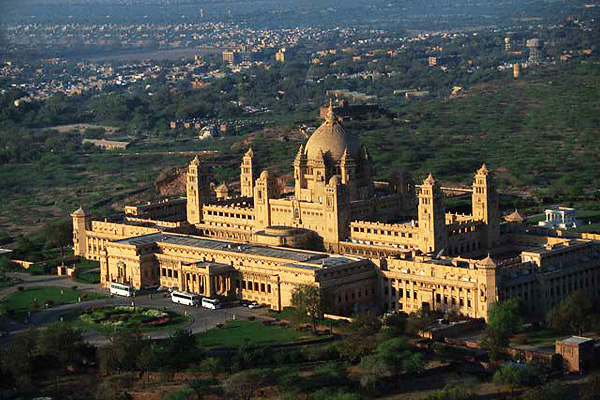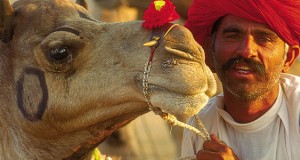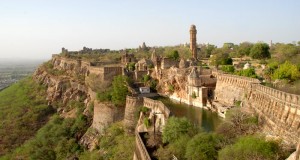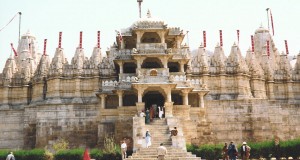Review Overview
3
Summary : Jodhpur is the second city of Rajasthan
Situated close to the edge of the Thar Desert, Jodhpur is the second city of Rajasthan. II was founded by Rao Jodha in 1459, following the capture of the nearby old capital of Mandate, home of the Rathore Rajputs since the 12th century. Lying on the rich ravan routes, it became a very wealthy city indeed, with stately palaces, Ileaiiti el buildings and gracious temples. Up until recently, it was capital of the state of Marwar.
Jodhpur’s pride is her mighty 15th-century fort, which stands on a low range of ▪landstone hills. It lies within the 10-km (3-mile) long stone wall encircling the old city and Las eight immense gates. Facing the fort, on the other side of the city, is the Umaid Bhawan Palace. A modern creation (completed 1945), it was the own maharaja’s way of keeping his population busy during a time of severe famine. Inlay is another of Rajasthan’s fantasy hotels.
Jodhpur is one of India’s most interesting cities, especially in the narrow, bustling ▪ bazaars of the old city, and there is a great deal to see and do. Yet it remains crously unappreciated. Most travellers use it simply as a jumping-off point to near by jaisalmer (west), Udaipur (south) and Jaipur (north-east), and rarely linger horn n than a day or two. This may have something to do with the heat (pretty severe’ exceIt from December to early March), but doubtless has a lot to do with jodhpur’s notoriety as a ‘hassle’ centre. Women travellers have a particularly difficult time here and everybody is plagued by kids chanting ‘Wottis your nem?’ and begging school pens. This is a shame, since few places in India have finer palaces or bazaars, and jodhpur’s fort is perhaps the best-preserved and most attractive in the country. 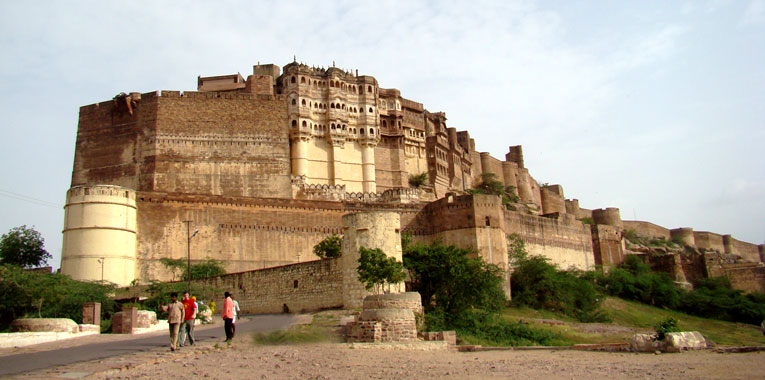
ARRARRIVAL/DEPARTURE
It Indian airlines has daily flights between Jodhpur and Ahmedabad (Rs893), Auran-gabad(Rs.1480), Bombay (Rs1629), Delhi (Rs1083), Jaipur (Rs767) and Udaipur (IRnds.i5n83).vayudoot offers occasional flights to Jaisalmer.
The Indian Airlines office is at the Ghoomar Tourist Bungalow (tel 28600, airport hvanadylinug adgeontos atre May ur Travels, Kalyan Singh Building, el 20909), The general airport enquiry tel. is 30617. II ily trains to Delhi, Jaipur, Udaipur and Jaisalmer. See travel itinerary I, for more details. The railway enquiry office is open from 10 am to 5 pm (tel)
Road [ Daily buses to Bikaner, Jaipur, Jaisalmer, Mt Abu, Ajmer, Ranakpur, Udaipur and Chittorgarh leave from Jodhpur’s Raika Bagh bus-stand. The State Road Transport Corporation office is open 10 am to 5 pm (tel 44686).
WHAT TO SEE For a large city, Jodhpur is quite easy to negotiate. The central market cuts through – the centre of town, with the tourist office, bus-stand and railway station to the south, – – e fort and the old city to the north. For in-town transport, you have auto-rickshaws real bandits: even locals have a hard time getting anywhere for less than Rs5), tempo minibuses (useful for visiting Mandore, and horse-drawn tongas (slow and expensive, around Rs4 /km). There are few taxis but cars can be hired from Umaid Bhavan Palace and other hotels. The best (cheapest) way of getting round is by cycle. There are many bike-hire places near the rail station, charging only Rs10 per day. Count on spending three full days in Jodhpur—it’s worth it. If you can’t digest all the suggested tours at one sitting, do a couple during your first visit, and pick up the last one on your return here from Jaisalmer.
City Tour (by rickshaw, or on foot; 4-6 hours)
Meherangarh Fort-Meherangarh Museum-Jaswant Thada-Umaid Gardens-Government Museum- Umaid Bhawan Palace and Museum From Jalori Gate, at the old city entrance, it’s a short auto-rickshaw ride (or 30-minute walk) up to Fatehpol, the entrance to the fort. The drive north takes you through the old city market, a teeming thoroughfare of narrow, winding lanes crammed with bicycles, carts, cows and camels. What you won’t see here isn’t worth mentioning— it’s a wild, colourful pot-pourri of street tailors, candle-makers, incense sellers, sugar-cane presses, glass and lantern shops, all casually observed by old men sitting in doorways propped on silver-topped cane sticks. If you get stuck in the narrow-lane traffic (and this is common) watch out for young lads playing games with live rats , (they throw them back and forth, the aim being to catch them by the tail, losers get * bitten). Flying rodents sometimes end up in stationary rickshaws.
The Meherangarh (Majestic) Fort is Rajasthan’s finest. Built on solid rock, towering 400 ft above the plains, this massive 15th-century fort was once described by Kipling as ‘the work of angels, fairies and giants’. It was never captured, and once you’ve made the climb up there—a crippling 30-minute ascent, via huge gates pocked with cannonball scars and daubed with sati handprints—you’ll know why.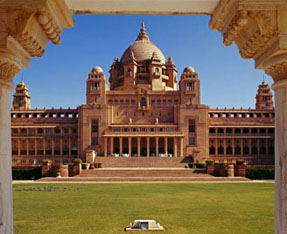
The remarkable Meherangarh Museum at the top, recently converted from the Fort Palace, is worth every paisa of the Rs10 admission. This charge includes a smartly uniformed guide, who will explain the history and contents of the museum in impeccable English. The Rs25 camera charge is a bit stiff but there is some excellent photography here.
The museum is open 9 am-5 pm daily in winter and 8 am-6 pm in summer, and houses 18 different sections, full of well-displayed antiquities. Nowhere else in India will you find so much opulence, ostentation and fine craftsmanship concentrated in one place. Starting with the chamber full of baby-carriages (home of many fledgling Maharajahs), moving on to the haveli-type ladies’ quarters with their stone-carved balconies, you’ll pass through a whole series of palaces and courtyards to reach the amazing royal bedroom (coloured Christmas balls dangling from the ceiling, wallto- wall exotic carpets, mirrors and mosaics instead of wallpaper) with its truly amazing centrepiece—the vast bed where the Maharajah entertained his 35 wives. Below is Maharajah Bhai Singh’s 18th-century Dancing Hall, with its famous pure gold ceiling (80 kg: 176 lbs of it), the Fort’s principal attraction. The armoury section has a brace of gigantic elephant guns, and leads on to a rich assortment of elephant howdahs, folk music instruments, palanquins, furniture and costumes.
This palace museum is in superb condition throughout. Unlike so many of India’s palace attractions, the mosaics of jewels and semi-precious stones painstakingly inlaid into marble walls, ceilings and floors have not been picked out by invaders (or tourists), leaving it in pretty much the same condition as when first built. In the tent room is a huge Mughal tent made of silk and velvet for Emperor Shah Jahan. If you’ve only time for one ‘sight’ in Jodhpur, make it this.
Outside the museum entrance, beggar musicians play for money. There’s one especially colourful gentleman decked out like a Rajput Acker Bilk, with bright red turban, orange-sleeved army jacket, and the most decorated trumpet I’ve ever seen. Take time to appreciate these artists—they’re great fun, and well worth a photo.
Certain sections of the fort (notably the ladies’ quarters inside the museum) give fine views down over the tenements and houses of the Brahmin quarter of town, unmistakable because they are painted bright blue. Blue is the pigment of Lord Krishna, and you’ll see a lot of Brahmin women here wearing blue clothing). But to see all this royal blue to best advantage, head out of the museum past the Sun Goddess (Chamundi) temple until you reach the fort rampart. This gives the best overall view over Jodhpur city, and has one of the rarest displays of cannon in India.
The exit from the fort is to the left as you leave the museum. Just above the Hero’s Chhatri (monument to brave hero who fell out of a window), there’s a sharp bend in the road. It’s the favourite pitch of boy musicians, on the fiddle. Here you can choose between heading left, down to the marble cenotaph of Jaswant Thada (cremation ground of the royal family, with translucent marble tombs and portraits of the 12 rulers of old Mandore, before the capital moved to present Jodhpur), or taking the crumbling stairway (on the bend) to the right, which takes you down into Sadar Market. This has a lively central square, with a clock tower, a barber’s circle and an umbrella-shaded cobbler’s corner. Beside the left-hand gate (one of three), there’s Sri Mishri Lal Hotel—famous for its rnakhania lassi, a rich, creamy drink made with cow’s milk, butterballs, cardamom and ice.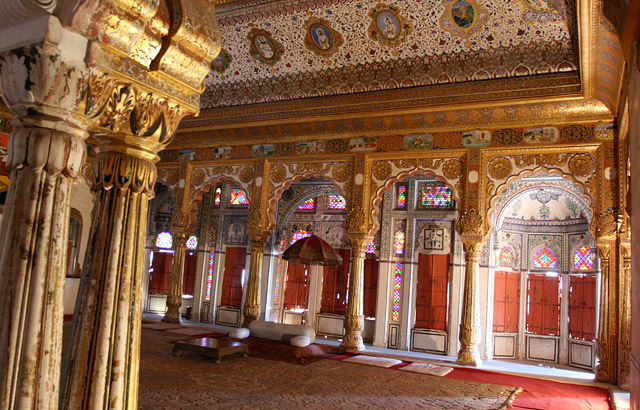
Outside the square, you can either head right into the festive Central Market or hire a horse-drawn tonga down New Road towards the Tourist Bungalow. Ask to be dropped off at the Umaid Public Gardens, a popular and attractive picnic spot. The green and well-maintained gardens are full of mango, bougainvillaea, roses and other flowering plants. The small zoo has some lethargic lions, who come out for a swim in the open-air pool when bored of sleeping. At the north-eastern end of the gardens, you’ll find the Government Museum. Open 10 am-5 pm (except Friday )„ admission Rsl, this has some nice porcelain and pottery pieces, some boring bits o old rock from Mandore, and some stuffed predators and reptiles restlessly roaming the walls. Above the old iron British turnstile at the entrance is a sign stating: ‘Dog and Hobnail Boots Not Allowed’ The museum has not seen much renovation in the last 40 years.
From the gardens, it’s a 20-minute walk south (via the Circuit House) to the stately Um aid Bhawan Palace. This was commenced in 1929 by Maharajah Umaid Singh, probably as ‘famine relief work’ for his drought-stricken subjects, and took the next 13 years (with 3000 labourers working day and night) to complete. Its architect, H.V. Far caster, was told to build a structure to rival, if not equal, that of Lutyens’ Delhi, the, under construction. The result was an exquisite example of the Art-Deco style of the ’30s, covering a built-up area of 3.5 acres. Many features, notably the side- !nit frets, are reminiscent of Lutyen’s Rashtrapati Bhavan in New Delhi.
The palace is a masterpiece of construction, fashioned completely of interlocking sandstone blocks—like a giant Lego set, it can be dismantled any time and reassembled anywhere . The structure is dominated by a central dome which rises 56 m high and prov ides a natural source of light and cross ventilat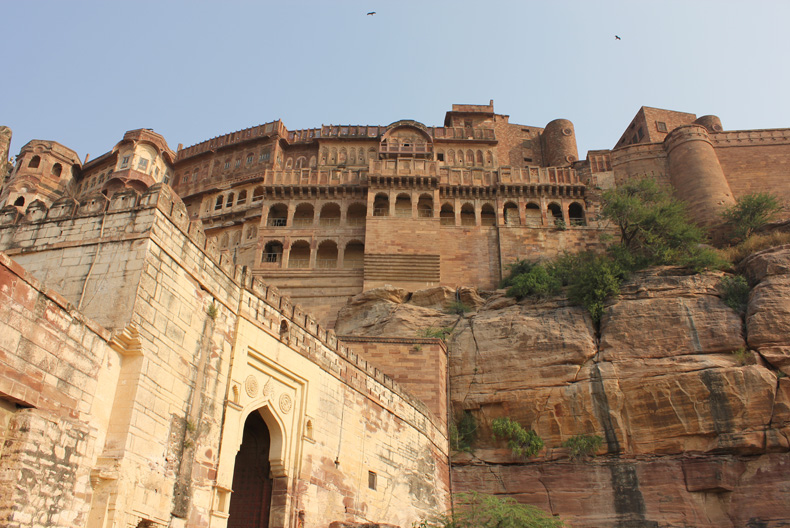 ion. Today the palace is part hotel, Isar maharajah’s residence, and part museum. The sophisticated young Maharajah ‘ till Ives in, making this the largest private residence in India. It’s also the most recent palace to be built in India.
ion. Today the palace is part hotel, Isar maharajah’s residence, and part museum. The sophisticated young Maharajah ‘ till Ives in, making this the largest private residence in India. It’s also the most recent palace to be built in India.
There are guided tours of Umaid Bhawan Palace and Museum every hour or so Iror 8.30 am to 5 pm daily. Entrance fee is Rs5. The museum has an illuminated toot 1 of the palace (prepared in England as a design model for the actual building), I tea iful miniature paintings, elegant Grecian-style paintings (by the famous Italian painter E. Norblin, 1946), delicate Japanese/Chinese china and pottery, an exquisite c ollection of clocks, and a 3-D portrait of Maharajah Umaid Singh. Wandering round Ike lace, you’ll find a weird Roman Bath and a stuffed bear waiter (with white gloves and wine tray) standing outside the restaurant. The whole thing is one big memory trip for anyone who remembers the Raj, and a real eye-opener for anyone who doesn’t.

